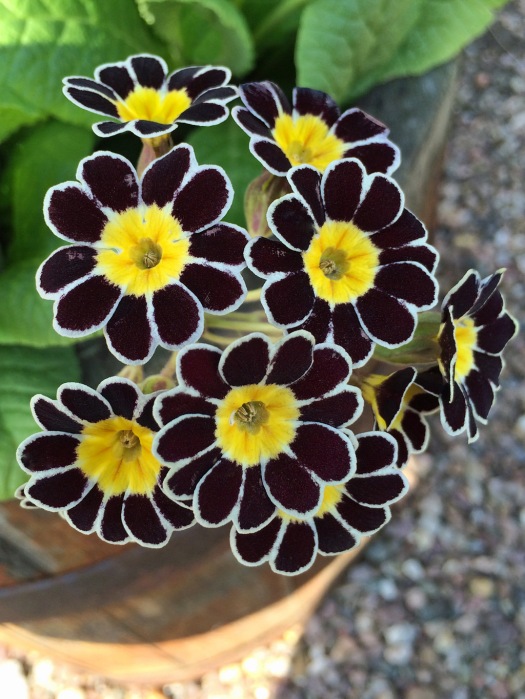Matt black flowers can sometimes be lost in a garden, but the silver lacing tracing the edges of the petals of this polyanthus – and the cheerful, golden yellow centres – are unlikely to be overlooked.
I often see mahogany coloured primroses with gold edges in local gardens, but the black and silver ones are less common. This specimen was part of a wonderful collection of plants my Mother and I were admiring at Bridgemere Nursery and Garden yesterday.
The old world charm of silver laced and gold laced polyanthus type primroses makes them perfectly at home in traditional cottage gardens. In a nod to their relatively long, sturdy stems and pretty clusters of blooms, they are sometimes called florists’ primroses. They are bee-friendly, providing welcome food for bees venturing out early in the season.
Primulas prefer that elusive, humus-rich soil: the type that is well-drained but doesn’t ever completely dry out. Breeders have developed seed strains of the laced types that should come true. An established clump is easy to propagate by splitting, which will help it thrive.
Primulas have long been collected and shown in England by amateurs who competed for prizes, often copper kettles, which would be hung outside public houses to advertise a competition.
If you’d like to find out more, visit the websites of specialist breeders such as Barnhaven Primroses and the local or national societies (e.g. Northern England or Midland and West England or USA).


This really is an eye opener Susan, great shot.
Thank you, Karen.
Thanks for the introduction to such a spectacular and unique flower. Your photo is just stunning!
I’m glad you like it. I think they were more popular with florists in the past – I haven’t seen them used often, except once or twice at floristry exhibitions at flower shows.
Oh my gosh! Never seen black flowers. They look like the colors should be reversed. How interesting…
Thanks – if you search for auricula primulas, (which are a different kind but often beautifully coloured) you’ll find lots of wonderful colours.
Shade or sun or partial shade?
Auriculas are usually grown in small clay pots in a cold greenhouse so they can be cool in summer, dryish in the winter.
Polyanthus primulas grow outside and like to have shade in summer – for example, under deciduous trees.
Wow, what an amazing little bloom. Definitely more of a black velvet dinner party kind of flower than a country picnic!
I rather like this one. It would fit in perfectly with my bruised collection – though that has dwindled somewhat over the past year. So is this one to grow outside? It does look like the Auriculas that are often found in an alpine house.
Yes, they’ll grow outside quite happily in the north of England. The flowers do look very much like auriculas, but their leaves are the primrose type and the petals haven’t got the fleshy character of auriculas.
I shall have to look out for one.